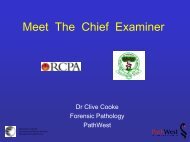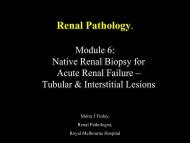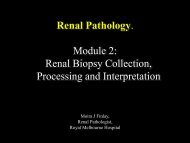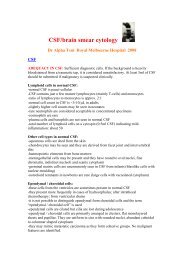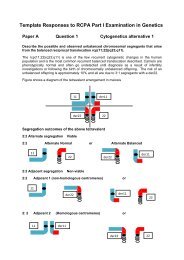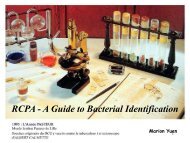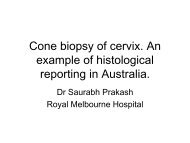RCPA Examinations in Anatomical pathology - Questions ... - Rcpa.tv
RCPA Examinations in Anatomical pathology - Questions ... - Rcpa.tv
RCPA Examinations in Anatomical pathology - Questions ... - Rcpa.tv
You also want an ePaper? Increase the reach of your titles
YUMPU automatically turns print PDFs into web optimized ePapers that Google loves.
Case 1: Female 36 – suspicious<br />
lesion on mammography<br />
• MICROSCOPIC<br />
• The breast tissue conta<strong>in</strong>s a well circumscribed <strong>in</strong>vasive tumour. There is one component of the tumour where<br />
the cells are arranged <strong>in</strong> large nests separated by fibrous bands. . With<strong>in</strong> the cell nests there is a predom<strong>in</strong>ance of<br />
small basaloid cells many of which surround aggregates of eos<strong>in</strong>ophilic homogeneous material. There are also<br />
true lumens present l<strong>in</strong>ed by cells with more abundant eos<strong>in</strong>ophilic ic cytoplasm. Surround<strong>in</strong>g this area of nested<br />
tumour there are <strong>in</strong>filtrat<strong>in</strong>g small tubules, nests and trabeculae e of tumour cells. Aga<strong>in</strong> these consists of both<br />
basaloid cells and cells with more abundant eos<strong>in</strong>ophilic cytoplasm surround<strong>in</strong>g true lumens.<br />
• Comment<br />
• The presence of small basaloid cells associated with more epithelial appear<strong>in</strong>g cells and aggregates of eos<strong>in</strong>ophilic<br />
material <strong>in</strong>dicates an adenoid cystic carc<strong>in</strong>oma. The differential l diagnosis <strong>in</strong>cludes an <strong>in</strong>filtrat<strong>in</strong>g cribriform<br />
carc<strong>in</strong>oma and <strong>in</strong> places the clear<strong>in</strong>g around some of the <strong>in</strong>filtrat<strong>in</strong>g t<strong>in</strong>g nests raises the possibility of a micropapillary<br />
carc<strong>in</strong>oma.<br />
• Investigations<br />
• Alcian blue, , PAS, immunoperoxidase sta<strong>in</strong>s for oestrogen and progestagen receptors<br />
• The eos<strong>in</strong>ophilic material present should show positive sta<strong>in</strong><strong>in</strong>g with Alcian blue and be negative for PAS with the<br />
true glandular lum<strong>in</strong>a show<strong>in</strong>g positive sta<strong>in</strong><strong>in</strong>g with PAS. Immunoperoxidase sta<strong>in</strong>s for oestrogen and<br />
progestagen receptors should be negative <strong>in</strong> adenoid cystic carc<strong>in</strong>oma with positive p<br />
sta<strong>in</strong><strong>in</strong>g <strong>in</strong> an <strong>in</strong>filtrat<strong>in</strong>g<br />
cribriform carc<strong>in</strong>oma and frequent positive sta<strong>in</strong><strong>in</strong>g <strong>in</strong> a micropapillary carc<strong>in</strong>oma.<br />
• SUMMARY/ Preferred diagnosis<br />
• Breast: Adenoid cystic carc<strong>in</strong>oma




